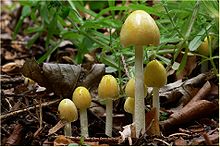|
Bolbitiaceae
The Bolbitiaceae are a family of mushroom-forming basidiomycete fungi. A 2008 estimate placed 17 genera and 287 species in the family.[2] Bolbitiaceae was circumscribed by mycologist Rolf Singer in 1948.[3] DescriptionThis family is of mushroom-forming species that have a hymenium on gills, brown spores and a hymenoderm pileipellis. Differences in generaBolbitius are mushrooms which are thin, Mycena-like, with gelatinous cap surface. These lack a veil, are saprotrophic, and tend to be found with grass. Conocybe are mushrooms which are thin, Mycena-like, with a dry cap surface. These are small and saprotrophic, and tend to be found with grass. These have cheilocystidia which are capitate. Pholiotina are mushrooms which are thin, Mycena-like, with a dry cap surface. These are small and saprotrophic, and tend to be found with grass, and have a veil. Some have a membranous veil, mid-stipe, others the veil breaks up and can be found on the cap margin. These are separated from Conocybe in that the cheilocystidia are non-capitate. Descolea includes Pholiotina-like mushrooms that are ectomycorrhizal and have limoniform spores.[1] See alsoReferencesWikispecies has information related to Cyphellopus.
|
||||||||||||||||||||||||||||
